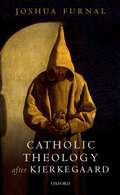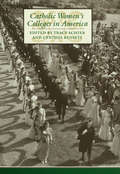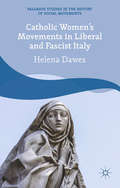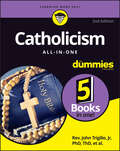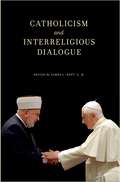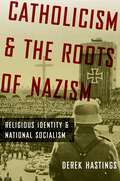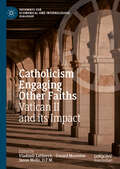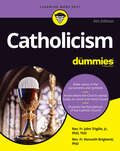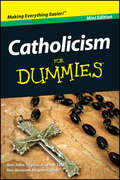- Table View
- List View
Catholic Theology: An Introduction
by Frederick C. Bauerschmidt James J. BuckleyIntroduction to Catholic Theology is an accessible but in-depth examination of the ways in which Catholic theology is rooted in and informs Catholic practice. Weaves together discussion of the Bible, historical texts, reflections by important theologians, and contemporary debates for a nuanced look at belief and practice within the Catholic faith Provides an overview of all major theological areas, including scriptural, historical, philosophical, systematic, liturgical, and moral theology Appropriate for students at all levels, assuming no prior knowledge yet providing enough insight and substance to interest those more familiar with the topic Written in a dynamic, engaging style by two professors with more than 50 years of classroom experience between them
Catholic Theology (Doing Theology)
by Tracey RowlandRowland showcases here the dominant contemporary approaches to doing Catholic theology. Chapter 1 offers a summary of the two International Theological Commission (ITC) documents on the discipline of Catholic theology. These documents set out the general principles which should govern any approach to Catholic theology (at least according to the ITC). The subsequent chapters each focus on one of four different approaches frequently found in contemporary Catholic academies: the approach of Thomists, members of the Communio milieu, members of the Concilium milieu and promoters of different varieties of Liberation Theology. Rowland's work is pitched at the level of first time students of theology who are trying to make sense of the methodological choices which undergird the different approaches to Catholic theology.Rowland concludes with four appendices: a list of all Doctors of the Church, a list of all encyclicals since the 19th century, a list of the documents of the Second Vatican Council, and a list of definitions of the various Christological heresies which were the subject of the debates of the early Church Councils. These appendices will provide useful reference tables for young scholars, including seminarians.
Catholic Theology: Essays In Catholic Theology (Doing Theology)
by Tracey RowlandRowland showcases here the dominant contemporary approaches to doing Catholic theology. Chapter 1 offers a summary of the two International Theological Commission (ITC) documents on the discipline of Catholic theology. These documents set out the general principles which should govern any approach to Catholic theology (at least according to the ITC). The subsequent chapters each focus on one of four different approaches frequently found in contemporary Catholic academies: the approach of Thomists, members of the Communio milieu, members of the Concilium milieu and promoters of different varieties of Liberation Theology. Rowland's work is pitched at the level of first time students of theology who are trying to make sense of the methodological choices which undergird the different approaches to Catholic theology.Rowland concludes with four appendices: a list of all Doctors of the Church, a list of all encyclicals since the 19th century, a list of the documents of the Second Vatican Council, and a list of definitions of the various Christological heresies which were the subject of the debates of the early Church Councils. These appendices will provide useful reference tables for young scholars, including seminarians.
Catholic Theology after Kierkegaard
by Joshua FurnalAlthough he is not always recognised as such, Søren Kierkegaard has been an important ally for Catholic theologians in the early twentieth century. Moreover, understanding this relationship and its origins offers valuable resources and insights to contemporary Catholic theology. Of course, there are some negative preconceptions to overcome. Historically, some Catholic readers have been suspicious of Kierkegaard, viewing him as an irrational Protestant irreconcilably at odds with Catholic thought. Nevertheless, the favourable mention of Kierkegaard in John Paul II's Fides et Ratio is an indication that Kierkegaard's writings are not so easily dismissed. Catholic Theology after Kierkegaard investigates the writings of emblematic Catholic thinkers in the twentieth century to assess their substantial engagement with Kierkegaard's writings. Joshua Furnal argues that Kierkegaard's writings have stimulated reform and renewal in twentieth-century Catholic theology, and should continue to do so today. To demonstrate Kierkegaard's relevance in pre-conciliar Catholic theology, Furnal examines the wider evidence of a Catholic reception of Kierkegaard in the early twentieth century-looking specifically at influential figures like Theodor Haecker, Romano Guardini, Erich Przywara, and other Roman Catholic thinkers that are typically associated with the ressourcement movement. In particular, Furnal focuses upon the writings of Henri de Lubac, Hans Urs von Balthasar, and the Italian Thomist, Cornelio Fabro as representative entry points.
Catholic Theology after Kierkegaard
by Joshua FurnalAlthough he is not always recognised as such, Søren Kierkegaard has been an important ally for Catholic theologians in the early twentieth century. Moreover, understanding this relationship and its origins offers valuable resources and insights to contemporary Catholic theology. Of course, there are some negative preconceptions to overcome. Historically, some Catholic readers have been suspicious of Kierkegaard, viewing him as an irrational Protestant irreconcilably at odds with Catholic thought. Nevertheless, the favourable mention of Kierkegaard in John Paul II's Fides et Ratio is an indication that Kierkegaard's writings are not so easily dismissed. Catholic Theology after Kierkegaard investigates the writings of emblematic Catholic thinkers in the twentieth century to assess their substantial engagement with Kierkegaard's writings. Joshua Furnal argues that Kierkegaard's writings have stimulated reform and renewal in twentieth-century Catholic theology, and should continue to do so today. To demonstrate Kierkegaard's relevance in pre-conciliar Catholic theology, Furnal examines the wider evidence of a Catholic reception of Kierkegaard in the early twentieth century-looking specifically at influential figures like Theodor Haecker, Romano Guardini, Erich Przywara, and other Roman Catholic thinkers that are typically associated with the ressourcement movement. In particular, Furnal focuses upon the writings of Henri de Lubac, Hans Urs von Balthasar, and the Italian Thomist, Cornelio Fabro as representative entry points.
Catholic Women and Mexican Politics, 1750–1940
by Margaret ChowningHow women preserved the power of the Catholic Church in Mexican political lifeWhat accounts for the enduring power of the Catholic Church, which withstood widespread and sustained anticlerical opposition in Mexico? Margaret Chowning locates an answer in the untold story of how the Mexican Catholic church in the nineteenth century excluded, then accepted, and then came to depend on women as leaders in church organizations.But much more than a study of women and the church or the feminization of piety, the book links new female lay associations beginning in the 1840s to the surprisingly early politicization of Catholic women in Mexico. Drawing on a wealth of archival materials spanning more than a century of Mexican political life, Chowning boldly argues that Catholic women played a vital role in the church’s resurrection as a political force in Mexico after liberal policies left it for dead.Shedding light on the importance of informal political power, this book places Catholic women at the forefront of Mexican conservatism and shows how they kept loyalty to the church strong when the church itself was weak.
Catholic Women's Colleges in America
by Tracy Schier Cynthia RussettMore than 150 colleges in the United States were founded by nuns, and over time they have served many constituencies, setting some educational trends while reflecting others. In Catholic Women's Colleges in America, Tracy Schier, Cynthia Russett, and their coauthors provide a comprehensive history of these institutions and how they met the challenges of broader educational change. The authors explore how and for whom the colleges were founded and the role of Catholic nuns in their founding and development. They examine the roots of the founders' spirituality and education; they discuss curricula, administration, and student life. And they describe the changes prompted by both the church and society beginning in the 1960s, when decreasing enrollments led some colleges to opt for coeducation, while others restructured their curricula, partnered with other Catholic colleges, developed specialized programs, or sought to broaden their base of funding.Contributors: Dorothy M. Brown, Georgetown University; David R. Contosta, Chestnut Hill College; Jill Ker Conway, Massachusetts Institute of Technology; Carol Hurd Green, Boston College; Monika K. Hellwig, Association of Catholic Colleges and Universities; Karen Kennelly, president emerita of Mount Saint Mary's College, Los Angeles; Jeanne Knoerle, president emerita of Saint Mary-of-the-Woods College; Thomas M. Landy, College of the Holy Cross; Kathleen A. Mahoney, Humanitas Foundation; Melanie M. Morey, Leadership and Legacy Associates, Boston; Mary J. Oates, Regis College; Jane C. Redmont, Graduate Theological Union in Berkeley; Cynthia Russett, Yale University; Tracy Schier, Boston College.
Catholic Women's Movements in Liberal and Fascist Italy (Palgrave Studies in the History of Social Movements)
by H. DawesIn the early 1900s the Catholic Church appealed, for the first time in its history, directly to women to reassert its religious, political and social relevance in Italian society. This book examines how the highly successful conservative Catholic women's movements that followed, and how they mobilized women against secular feminism.
Catholicism: Teach Yourself
by Peter StanfordEVERYTHING YOU NEED TO KNOW ABOUT CATHOLICISM, ALL IN ONE PLACEThis is your go-to guide to the Catholic faith. It covers the basics and history of Catholicism, the Catholic Church today and teachings and traditions. It is your comprehensive and essential account of Catholic doctrine, faith and history. On the world stage, Catholicism is the largest of the branches of Christianity with over 1.2 billion followers. How has the Catholic Church's message reached into every corner of the globe, and what challenges does it face now and in the future?Catholicism: A Complete Introduction is a thorough and structured overview of the subject, covering the basics of the faith, the history of Catholicism, the role of the papacy, and teachings and traditions within the Church. It includes topics as diverse as the role of women in the Catholic Church, the celebrity of the Pope, and how 2000-year-old traditions still shape what it is to be a Catholic in the 21st century. Broken down into easy-to read parts, it includes insights, topic summaries and case studies to encourage further study and reflection.This edition also examines the 'Francis effect', the extraordinary global impact of the election of Pope Francis in 2013, and the shift his arrival has caused within and outside of the Church. Whether you simply want to expand your knowledge of the Catholic faith, or you're studying for an exam or essay, Catholicism: A Complete Introduction is your essential guide.ABOUT THE SERIESThe Complete Introduction series is the ultimate one-stop guide for anyone wanting a comprehensive and accessible entry point into subjects as diverse as philosophy, mathematics, psychology and practical electronics. Loved by students and perfect for general readers who simply want to learn more about the world around them, these books are your first choice for discovering something new.
Catholicism: A comprehensive guide to the history, beliefs and practices of the Catholic faith (Teach Yourself)
by Peter StanfordThis is a complete guide to the oldest institution in the Western world - the Catholic Church. Explore the essential beliefs and practices of the religion and delve into its long and fascinating history. From the significance of Rome and the importance of the Papacy, to current issues such as science, contraception and new movements within the faith, learn what it means to be Catholic today.NOT GOT MUCH TIME?One, five and ten-minute introductions to key principles to get you started.AUTHOR INSIGHTSLots of instant help with common problems and quick tips for success, based on the author's many years of experience.TEST YOURSELFTests in the book and online to keep track of your progress.EXTEND YOUR KNOWLEDGEExtra online articles at www.teachyourself.com to give you a richer understanding of psychology.FIVE THINGS TO REMEMBERQuick refreshers to help you remember the key facts.TRY THISInnovative exercises illustrate what you've learnt and how to use it.
Catholicism All-In-One For Dummies
by Consumer DummiesGrasp the beliefs and practices about one of the world's oldest religions Catholicism All-In-One For Dummies is your all-inclusive guide to the Catholic Church and its billions of followers. You'll learn how Catholicism came to be, how it's practiced, and where it stands socially and politically as you explore the rich history and diverse culture surrounding this major religion. Clear, friendly writing takes you inside a mass to understand what happens there, and walks you through a tour of the saints, holidays, the Bible, and the Vatican. Special coverage includes the role of women in the Church and in the Bible, and the tremendous popularity of Pope Francis, who has quickly become one of the Vatican's most-loved leaders. You'll dive into the beliefs and practices of Catholicism and get answers to the most common, confusing, controversial, and worrisome questions. Catholicism is quickly expanding beyond its 1.2 billion followers, with growing numbers of priests and new baptisms every year. Attendance at papal events has tripled to 6.6 million since Pope Francis' election in 2013, and Catholicism has become the largest religious denomination on the planet by a wide margin. This book explains what makes Catholicism so alluring, giving you insight into the religion and everything it entails. Discover the complicated history of the Catholic church Understand what goes on at mass, and why Learn where the Church stands on important issues Explore Pope Francis's unprecedented popularity across cultures The Catholic Church has been reinvigorated and revitalized with the enthusiasm surrounding Pope Francis, and his openness to the world and everyone in it. If your curiosity has been piqued, Catholicism All-In-One For Dummies is the ideal guide to learning what it's all about.
Catholicism All-In-One For Dummies
by Consumer DummiesGrasp the beliefs and practices about one of the world's oldest religions Catholicism All-In-One For Dummies is your all-inclusive guide to the Catholic Church and its billions of followers. You'll learn how Catholicism came to be, how it's practiced, and where it stands socially and politically as you explore the rich history and diverse culture surrounding this major religion. Clear, friendly writing takes you inside a mass to understand what happens there, and walks you through a tour of the saints, holidays, the Bible, and the Vatican. Special coverage includes the role of women in the Church and in the Bible, and the tremendous popularity of Pope Francis, who has quickly become one of the Vatican's most-loved leaders. You'll dive into the beliefs and practices of Catholicism and get answers to the most common, confusing, controversial, and worrisome questions. Catholicism is quickly expanding beyond its 1.2 billion followers, with growing numbers of priests and new baptisms every year. Attendance at papal events has tripled to 6.6 million since Pope Francis' election in 2013, and Catholicism has become the largest religious denomination on the planet by a wide margin. This book explains what makes Catholicism so alluring, giving you insight into the religion and everything it entails. Discover the complicated history of the Catholic church Understand what goes on at mass, and why Learn where the Church stands on important issues Explore Pope Francis's unprecedented popularity across cultures The Catholic Church has been reinvigorated and revitalized with the enthusiasm surrounding Pope Francis, and his openness to the world and everyone in it. If your curiosity has been piqued, Catholicism All-In-One For Dummies is the ideal guide to learning what it's all about.
Catholicism All-in-One For Dummies
by Rev. John Trigilio Jr. Rev. Kenneth Brighenti Rev. Monsignor James Cafone Rev. Jonathan Toborowsky Annie SullivanLet there be light—illuminating info about today’s Catholic church Catholicism All-in-One For Dummies offers a path toward understanding the beliefs of the Catholic church and how the church operates. Fully updated with information on newly canonized saints, updated teachings from Pope Francis, and how Catholic beliefs intersect with the modern world, this edition gets you up to date with the last 2000 or so years or Catholic history. With five minibooks in one, this friendly Dummies guide will answer your pressing questions. What do Catholics believe? What happens in Mass? Who are the saints? What is the role of the Pope? And other cool stuff you’ve been wanting to know about this Christianity denomination with over one billion members worldwide. Discover the core tenets of the Catholic religion Learn all about the papacy and get to know Pope Francis Get a primer on the Catholic saints, including those newly canonized Walk through the traditions of Mass and the seven sacramentsThis is an excellent resource for anyone who needs a clear guide to the practices and rules of the Catholic faith and wants a fascinating look into a prominent world religion.
Catholicism All-in-One For Dummies
by Rev. John Trigilio Jr. Rev. Kenneth Brighenti Rev. Monsignor James Cafone Rev. Jonathan Toborowsky Annie SullivanLet there be light—illuminating info about today’s Catholic church Catholicism All-in-One For Dummies offers a path toward understanding the beliefs of the Catholic church and how the church operates. Fully updated with information on newly canonized saints, updated teachings from Pope Francis, and how Catholic beliefs intersect with the modern world, this edition gets you up to date with the last 2000 or so years or Catholic history. With five minibooks in one, this friendly Dummies guide will answer your pressing questions. What do Catholics believe? What happens in Mass? Who are the saints? What is the role of the Pope? And other cool stuff you’ve been wanting to know about this Christianity denomination with over one billion members worldwide. Discover the core tenets of the Catholic religion Learn all about the papacy and get to know Pope Francis Get a primer on the Catholic saints, including those newly canonized Walk through the traditions of Mass and the seven sacramentsThis is an excellent resource for anyone who needs a clear guide to the practices and rules of the Catholic faith and wants a fascinating look into a prominent world religion.
Catholicism and Anti-Catholicism in Early Modern English Texts (Early Modern Literature in History)
by Arthur E. MarottiResponding to recent historical analyses of Post-Reformation English Catholicism, the essays in this collection by both literary scholars and historians focus on polemical, devotional, political, and literary texts that dramatize the conflicts between context-sensitive Catholic and anti-Catholic discourses in early modern England. They foreground some major literary authors and canonical texts, but also examine non-canonical literature as well as other writings that embody ideological fantasies connecting the political and religious discourses of the time with their literary manifestations.
Catholicism and Crisis in Modern France (PDF)
by William BosworthThe author discusses the role of French Catholicism in the internal and foreign affairs of modern France, with a detailed examination of French Catholic groups and their effect on temporal life. Presenting a wealth of material from official archives and files of French Catholic periodicals and organizations, Mr. Bosworth supplements his research by direct interviews with key personnel from a variety of Catholic groups.Originally published in 1961.The Princeton Legacy Library uses the latest print-on-demand technology to again make available previously out-of-print books from the distinguished backlist of Princeton University Press. These editions preserve the original texts of these important books while presenting them in durable paperback and hardcover editions. The goal of the Princeton Legacy Library is to vastly increase access to the rich scholarly heritage found in the thousands of books published by Princeton University Press since its founding in 1905.
Catholicism and Interreligious Dialogue
by James L. HeftHow can the world's many religions overcome ideological differences and come together to promote understanding, justice and peace? In this groundbreaking volume, James L. Heft and fifteen other leading scholars of the world's major religions show how to answer this crucial question.
Catholicism and Politics in Argentina, 1810-1960 (St Antony's Series)
by Austen IvereighA rare study of Catholicism in Latin-American politics prior to Vatican II, this work examines the role of Catholics and Catholic theology in the development of Argentine political history. The author challenges standard interpretations in arguing that Argentine authoritarianism derives principally from the Enlightenment offshoots of liberalism and popular nationalism. The author argues that the tension between these strains, and a broad humanistic cultural framework informed by the Catholic tradition, helps to explain Argentine political instability, while shedding new light on leaders and movements, and especially Peronism.
Catholicism and Science (Greenwood Guides to Science and Religion)
by Peter M.J Hess Paul L. AllenWhen most people think about Catholicism and science, they will automatically think of one of the famous events in the history of science - the condemnation of Galileo by the Roman Catholic Church. But the interaction of Catholics with science has been - and is - far more complex and positive than that depicted in the legend of the Galileo affair. Understanding the natural world has always been a strength of Catholic thought and research - from the great theologians of the Middle Ages to the present day - and science has been a hallmark of Catholic education for centuries.Catholicism and Science, a volume in the Greenwood Guides to Science and Religion series, covers all aspects of the relationship of science and the Church: How Catholics interacted with the profound changes in the physical sciences (natural philosophy) and biological sciences (natural history) during the Scientific Revolution; how Catholic scientists reacted to the theory of evolution and their attempts to make evolution compatible with Catholic theology; and the implications of Roman Catholic doctrinal and moral teachings for neuroscientific research, and for investigation into genetics and cloning.The volume includes primary source documents, a glossary and timeline of important events, and an annotated bibliography of the most useful works for further research
Catholicism and the Roots of Nazism: Religious Identity and National Socialism
by Derek HastingsDerek Hastings here illuminates an important and largely overlooked aspect of early Nazi history, going back to the years after World War I--when National Socialism first emerged--to reveal its close early ties with Catholicism. Although an antagonistic relationship between the Catholic Church and Hitler's regime developed later during the Third Reich, the early Nazi movement was born in Munich, a city whose population was overwhelmingly Catholic. Focusing on Munich and the surrounding area, Hastings shows how Catholics played a central and hitherto overlooked role in the Nazi movement before the 1923 Beerhall Putsch. He examines the activism of individual Catholic writers, university students, and priests and the striking Catholic-oriented appeals and imagery formulated by the movement. He then discusses why the Nazis embarked on a different path following the party's reconstitution in early 1925, ultimately taking on an increasingly anti-Catholic and anti-Christian identity.
Catholicism and the Roots of Nazism: Religious Identity and National Socialism
by Derek HastingsDerek Hastings here illuminates an important and largely overlooked aspect of early Nazi history, going back to the years after World War I--when National Socialism first emerged--to reveal its close early ties with Catholicism. Although an antagonistic relationship between the Catholic Church and Hitler's regime developed later during the Third Reich, the early Nazi movement was born in Munich, a city whose population was overwhelmingly Catholic. Focusing on Munich and the surrounding area, Hastings shows how Catholics played a central and hitherto overlooked role in the Nazi movement before the 1923 Beerhall Putsch. He examines the activism of individual Catholic writers, university students, and priests and the striking Catholic-oriented appeals and imagery formulated by the movement. He then discusses why the Nazis embarked on a different path following the party's reconstitution in early 1925, ultimately taking on an increasingly anti-Catholic and anti-Christian identity.
Catholicism Engaging Other Faiths: Vatican II and its Impact (Pathways for Ecumenical and Interreligious Dialogue)
by Vladimir Latinovic Gerard Mannion Jason Welle O.F.M.This book assesses how Vatican II opened up the Catholic Church to encounter, dialogue, and engagement with other world religions. Opening with a contribution from the President of the Pontifical Council for Interreligious Dialogue, Cardinal Jean-Louis Tauran, it next explores the impact, relevance, and promise of the Declaration Nostra Aetate before turning to consider how Vatican II in general has influenced interfaith dialogue and the intellectual and comparative study of world religions in the postconciliar decades, as well as the contribution of particular past and present thinkers to the formation of current interreligious and comparative theological methods. Additionally, chapters consider interreligious dialogue vis-à-vis theological anthropology in conciliar documents; openness to the spiritual practices of other faith traditions as a way of encouraging positive interreligious encounter; the role of lay and new ecclesial movements in interreligious dialogue; and the development of Monastic Interreligious Dialogue. Finally, it includes a range of perspectives on the fruits and future of Vatican’s II’s opening to particular faiths such as Judaism, Islam, Hinduism, and Buddhism.
Catholicism For Dummies
by Trigilio Rev. Kenneth BrighentiPeer through the stained glass and get an inside look at Christianity's most popular religion Catholicism can seem a bit mysterious to non-Catholics—and even Catholics. Embrace your curiosity and turn to Dummies for answers! Full of fascinating facts and written in a friendly style, Catholicism For Dummies explains the basics of Catholic beliefs like the importance of Sunday Mass; the seven sacraments; the purity of the Blessed Virgin Mary; heaven, hell, and purgatory; the Trinity; and so much more. You'll learn about the Catholic perspective on women as priests, saints as examples of how to live, and prayer as the basis of a relationship with God. This easy-to-read resource offers an overview of a rich and diverse faith. You'll also discover: The ins and outs of living as a Catholic and why followers of the faith observe traditions like attending Mass on certain days of the year, praying the rosary, and not eating meat on Fridays Information on what the pope does, how he is selected, the history of the Vatican, and what it's like to be a priest in today's society Details about the church's position on modern social issues, like poverty, abortion and the death penalty, same-sex marriage, and contraception Whether you're a cradle Catholic or just curious about the world's second largest religion, Catholicism For Dummies has the answers you're seeking to a faith that's been around for thousands of years. Order your copy today.
Catholicism For Dummies
by Trigilio Rev. Kenneth BrighentiPeer through the stained glass and get an inside look at Christianity's most popular religion Catholicism can seem a bit mysterious to non-Catholics—and even Catholics. Embrace your curiosity and turn to Dummies for answers! Full of fascinating facts and written in a friendly style, Catholicism For Dummies explains the basics of Catholic beliefs like the importance of Sunday Mass; the seven sacraments; the purity of the Blessed Virgin Mary; heaven, hell, and purgatory; the Trinity; and so much more. You'll learn about the Catholic perspective on women as priests, saints as examples of how to live, and prayer as the basis of a relationship with God. This easy-to-read resource offers an overview of a rich and diverse faith. You'll also discover: The ins and outs of living as a Catholic and why followers of the faith observe traditions like attending Mass on certain days of the year, praying the rosary, and not eating meat on Fridays Information on what the pope does, how he is selected, the history of the Vatican, and what it's like to be a priest in today's society Details about the church's position on modern social issues, like poverty, abortion and the death penalty, same-sex marriage, and contraception Whether you're a cradle Catholic or just curious about the world's second largest religion, Catholicism For Dummies has the answers you're seeking to a faith that's been around for thousands of years. Order your copy today.
Catholicism For Dummies, Mini Edition
by Rev John Trigilio Jr. Rev Kenneth BrighentiNo synopsis available.


